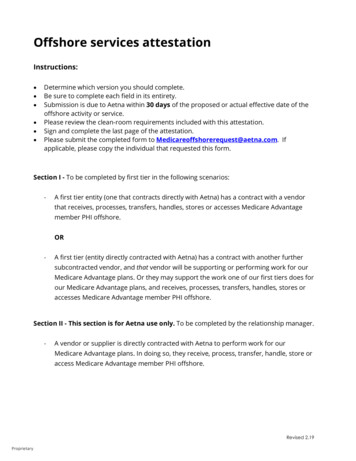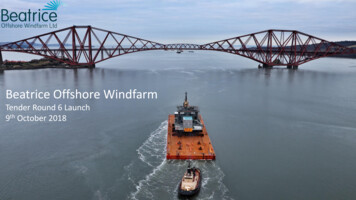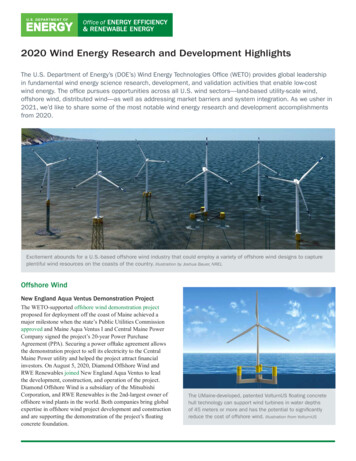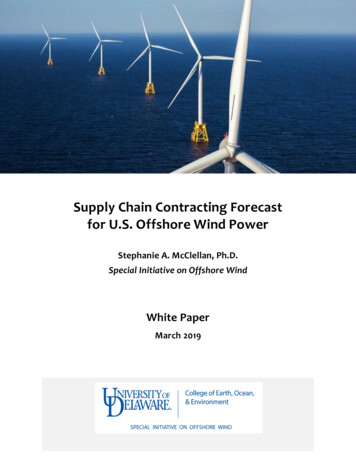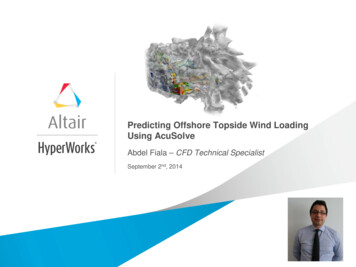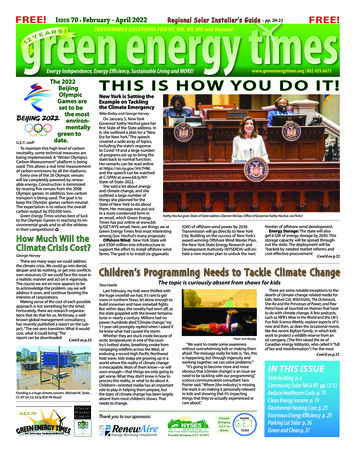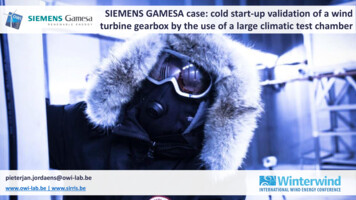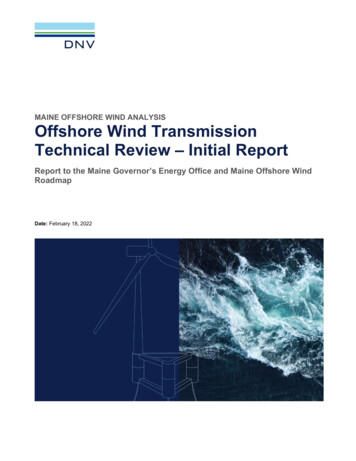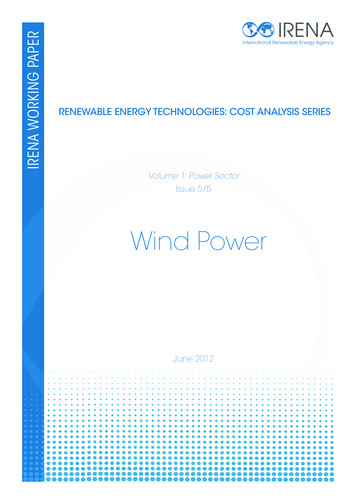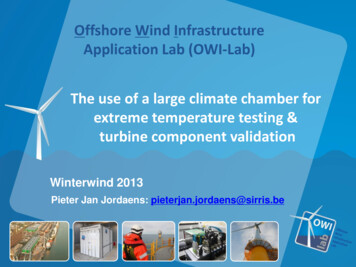
Transcription
Offshore Wind InfrastructureApplication Lab (OWI-Lab)The use of a large climate chamber forextreme temperature testing &turbine component validationWinterwind 2013Pieter Jan Jordaens: pieterjan.jordaens@sirris.be
General introductionReliability & RobustnessReducing O&M costLaboratory testing in wind energy applications(Extreme) temperature testsCases: gearbox, transformer, switch gear (BOP)Remote located wind turbinesWhat is OWI-Lab?Cold climate wind turbinesLarge climate chamber testingConclusions
IntroductionCollective centre ofthe Belgian technology industry Non-profit organisation Industry ownedMission: To help companies implementtechnological innovations
IntroductionAntwerpOffshore Wind InfrastructureApplication LabGhentMaterials EngineeringMaterials Research Cluster GentHasseltMaterials EngineeringProduction TechnologySmart Coating Application LabLeuvenMechatronicsTechnology CoachingSirris Leuven Composites Application LabLiègeAdditive ManufacturingMaterials EngineeringSirris Microfabrication Application LabBrusselsSoftware Engineering & ICTTechnology CoachingCharleroiAdditive ManufacturingBio-manufacturing platform
OWI-Lab 5.5 mio investments in stateof-the-art test & monitoring infrastructureStationary andFloating LIDAR(FLIDAR )Remotemeasurement& monitoringsystems(SHM & CMS)Wind turbinecomponentTest Lab withlarge climate chamber(Temperature testing)Development oftools forsmart O&M
Offering OWI-Lab(Raw)DATATest & MeasurementservicesTest & Monitoring InfrastructureDATA(Processed)Information &insightsKnowledge Design purpose (CAPEX) O&M purpose (OPEX) Higher energy yield
Remote located wind turbines
Specialized tools and equipment needed Harsh and difficult conditions Trained professionals needed Expensive maintenance tasks
In general 2 strategies:Source HighWindHow to reduce theses O&M costsNew efficient maintenance tools & equipmentDesign for maintainabilityCondition monitoring & SHMPredictive maintenance strategies & toolsReliable weather forecasting tools Source OWI-lab Source Gamesa1. Reducing costs to perform maintenance
How to reduce theses O&M costsIn general 2 strategies:2. Improving component robustness & reliability throughoutthe whole product development cycleDesign forrobustness& reliabilityImprovingRobustness& reliabilityTroughTESTINGQuality
Improving Robustness & reliabilityTrough TESTING In general three kinds of testing:1. End-of-line testing1232. Development testing3. Endurance testingSource LorcSource OWI-LabSource Vestas Sub-component, component, and full system level
Picture GamesaExamples component testingSource GamesaMAIN BEARINGCooling systemSource EatonFULL DRIVETRAINSourceRENKSourceFraunhoferSource DeutscheWindguardROTORSANEMOMETERSource CGTRANSFORMERCOUPLINGSource OrmazabalSourceFraunhoferSourceFraunhoferMAIN SHAFTPITCHYAW DRIVE BEARINGSGEARBOXSource NRELSource ZF Wind PowerSource FAGSource NordexSource HydratechCONVERTORGENERATOR
Which factors to test? Depends on the location of the wind turbine: Location: onshore, offshore, cold climate, desert, Wind speeds classification Environmental factors The IEC 61400-1 suggestsconsidering environmentalfactors in design & testingof wind turbines.
Why extreme temperature testing? On & offshore wind turbines standard designed to operate in temp. range of-10 C 40 C. In some cold climate regions turbine need to operate at -40 C or even-50 C ; in hot regions 50 C can occur. A proper cold start procedure has big influence on the reliability andproductivity (idling & heating strategy). Storage specifications of turbine components can even be lower than theoperating condition. Example from components in an offshore turbine (client specification): Storage: -40 C to 50 C Operation: -20 C to 30 C
Why extreme temperature testing? Possible impacts of (extreme) temperatures: Differential thermal expansion of(sub)-components and materials. Lubrication can become more or lessviscous which effects the oil/grease flow inbearing, raceways, gears. Materials can become brittle atlow temperatures (metals, rubbers, plastics) Cooling systems can experience overheatingproblems, during extreme heat Performance and efficiency change due totemperature variations Source: Arevagearbox oil @-30 CSource: VoithSource: JaKe
Large climate chambers exist for development testing Commonly used in the automotive, aerospace,defense industry for robustness & reliability tests No PUBLIC climate chambers yet specialized forwind energy application and heavy machinery capable of handling heavy weights(multi-MW components) dedicated auxiliaries for system testing
Large climate chamber for heavy machinery Located at breakbulk terminal in the Port of AntwerpMaximum test dimensions: 10m x 7m x 8m (LxWxH)Test volume: 560m³Temperature test range: -60 C 60 C45ton/m² capacity ; components up to 150 ton150 kW cooling capacity @ 60 C250kW cooling capacity @-20 C40 kW cooling capacity @-60 CCooling down rate: Empty chamber 20 C -60 C: 1 hour 100 ton steel: 60 hours Heating up rate: 100 ton steel -60 C 20 C: 48 hours
Why Climate chamber tests on wind turbine components? Prototype development & optimization tests Model validation Performance tests Design verification Certification testsExamples: Gearboxes, Transformers, Power convertors, Pitch & yaw systems,Switch gears, Hydraulics, Cooling & heating systems, Maintenance lifts,
Case: gearbox cold start test Check behavior grease and oils at -30 C/ -40 C(influence of viscosity on start-up) Check influence on sealing (prevent leakage)(temperature effect on materials: rubbers, metals, plastics) Proper heating strategy by external oil heater Check cold start-up time
Case: transformer cold testCase: Cold test CG SLIM transformerfor offshore turbine Short circuit test Storage test
Case: switch gear cold testAlso Balance Of Plant (BOP)systems need to be robust(Case Alstom Hypact @ -60 C)Source Siemens, Alstom, ABBSource Alstom
What else to test? Not only large components like gearboxesand transformers. Different turbine components need to be testedfor environmental impacts (cold, corrosion,humidity, ) if there is a risk for failure by thesefactors.Source Sky Man Field testing provides experience and knowledge,but testing in a controlled environment lowerscost and increases time-to-market.Source Siemens
Conclusions Reliability & robustness is key for wind turbines at remote locations. Extreme environmental scenario’s have to be tested. Advanced testing becomes more and more important to reduce the timeto-market of turbine components, ensure reliability to clients and to obtaincertification. (Extreme) temperature testing is needed for the validation of certaincomponents. OWI-lab invested in a large climate chamber in order to supportmanufacturers in the testing process .
Mechatronics Technology Coaching Sirris Leuven Composites Application Lab . . Certification tests Examples: Gearboxes, Transformers, Power convertors, Pitch & yaw systems, . Source Siemens, Alstom, ABB . What else to test? Not only large components like gearboxes and transformers.
